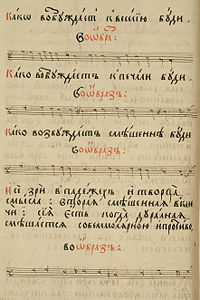
Nikolay Diletsky
Encyclopedia

Kiev
Kiev or Kyiv is the capital and the largest city of Ukraine, located in the north central part of the country on the Dnieper River. The population as of the 2001 census was 2,611,300. However, higher numbers have been cited in the press....
– after 1680, Moscow
Moscow
Moscow is the capital, the most populous city, and the most populous federal subject of Russia. The city is a major political, economic, cultural, scientific, religious, financial, educational, and transportation centre of Russia and the continent...
) was a theorist
Music theory
Music theory is the study of how music works. It examines the language and notation of music. It seeks to identify patterns and structures in composers' techniques across or within genres, styles, or historical periods...
and composer of Ukrainian
Ukraine
Ukraine is a country in Eastern Europe. It has an area of 603,628 km², making it the second largest contiguous country on the European continent, after Russia...
nationality, active in Russia
Russia
Russia or , officially known as both Russia and the Russian Federation , is a country in northern Eurasia. It is a federal semi-presidential republic, comprising 83 federal subjects...
. He was widely influential in late 17th-century Russia with his treatise on composition, A Musical Grammar, first survived version of which dated 1677. Diletsky's followers included Vasily Titov
Vasily Polikarpovich Titov
Vasily Polikarpovich Titov was a Russian composer, one of the foremost exponents of the so-called Moscow Baroque. Although Titov's works are not widely known today, he was famous during his lifetime, and his importance was acknowledged in Russia by both pre-revolutionary and Soviet...
.
Life

Kiev
Kiev or Kyiv is the capital and the largest city of Ukraine, located in the north central part of the country on the Dnieper River. The population as of the 2001 census was 2,611,300. However, higher numbers have been cited in the press....
, is considered evidence of the Diletsky's Ukrainian origins. Korenev's statement is probably reliable, as he and Diletsky apparently were well acquainted. However, the date and even the year of birth are not known, and no details on Diletsky's early life have surfaced. He must have moved to Vilnius
Vilnius
Vilnius is the capital of Lithuania, and its largest city, with a population of 560,190 as of 2010. It is the seat of the Vilnius city municipality and of the Vilnius district municipality. It is also the capital of Vilnius County...
before 1675, because that year his Toga zlota ("The golden toga") was published there. The text is now lost, but it is known that it was written in Polish, and the surviving title page indicates that it was probably a panegyric
Panegyric
A panegyric is a formal public speech, or written verse, delivered in high praise of a person or thing, a generally highly studied and discriminating eulogy, not expected to be critical. It is derived from the Greek πανηγυρικός meaning "a speech fit for a general assembly"...
al pamphlet. He also wrote here now lost musical treatise, apparently in Polish, as some sources indicate. This treatise is first mentioned in Grammatika musikiyskago peniya (1677). The Idea grammatikii musikiiskoi (1679) is described as a translation of the Vilnius work in its title page.
After Vilnius, Diletsky lived in Smolensk
Smolensk
Smolensk is a city and the administrative center of Smolensk Oblast, Russia, located on the Dnieper River. Situated west-southwest of Moscow, this walled city was destroyed several times throughout its long history since it was on the invasion routes of both Napoleon and Hitler. Today, Smolensk...
, where in 1677 the first survived version of his magnum opus, Grammatika musikiyskago peniya ("A grammar of musical song"), was written. He then moved to Moscow, where the subsequent two versions of the work appeared in 1679 and 1681. Nothing further is known about Diletsky's life, and it is generally assumed that he died shortly afterwards. His date of birth is projected from this hypothesis.
Work

Hexachord
In music, a hexachord is a collection of six pitch classes including six-note segments of a scale or tone row. The term was adopted in the Middle Ages and adapted in the twentieth-century in Milton Babbitt's serial theory.-Middle Ages:...
", and the second teaches composition of a cappella
A cappella
A cappella music is specifically solo or group singing without instrumental sound, or a piece intended to be performed in this way. It is the opposite of cantata, which is accompanied singing. A cappella was originally intended to differentiate between Renaissance polyphony and Baroque concertato...
concerto
Concerto
A concerto is a musical work usually composed in three parts or movements, in which one solo instrument is accompanied by an orchestra.The etymology is uncertain, but the word seems to have originated from the conjunction of the two Latin words...
s, a genre that came to Russia through Ukraine and of which Diletsky was one of the first exponents. Diletsky provides a wide variety of examples, both from his own work, including an 8-voice setting of the Divine Liturgy that he composed in Smolensk specifically to illustrate the "Grammatika", and from that of contemporary Western composers, particularly the Poles Marcin Mielczewski and Jacek Rózycki. Apart from the tremendous influence it had on subsequent generations of Russian church composers, the Grammatika is of particular interest for having the first known description of the circle of fifths
Circle of fifths
In music theory, the circle of fifths shows the relationships among the 12 tones of the chromatic scale, their corresponding key signatures, and the associated major and minor keys...
, one that antedates Western examples by several decades.
Writings
- Grammatika musikiyskago peniya (Грамматика муcикийского пения, "A grammar of musical song", Smolensk, 1677)
- Idea grammatikii musikiyskoy (Идея грамматикии муcикийской, "An idea of musical grammar", Moscow, 1679)
- Grammatika peniya musikiyskago (Грамматика пения муcикийского, Moscow, 1681)
Music
- 3 settings of the Divine Liturgy (4–8 voices, includes "Kyivan Chant" and a "Proportional" liturgy)
- 2 sacred concertos
- Resurrection/Easter kanon, 8vv

